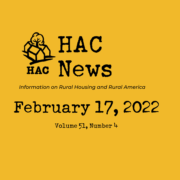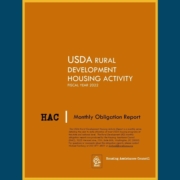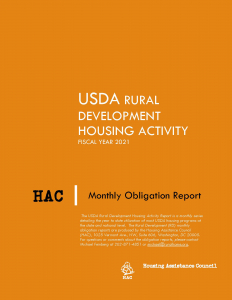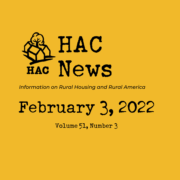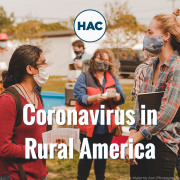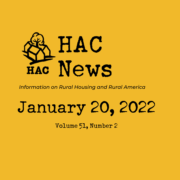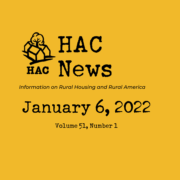HAC News: March 3, 2022
Vol. 51, No. 5
TOP STORIES
Federal funding deadline now March 11.
Assistance for Ukraine has complicated Congress’s efforts to adopt an omnibus measure to fund the federal government for fiscal year 2022 before the current continuing resolution expires on March 11. Contents of an omnibus bill have not yet been released. Last year the House and Senate considered differing proposals for USDA and HUD programs. The FY23 funding process will begin soon as well, with the Biden administration’s budget proposal expected to be released sometime in March.
New public charge regulation proposed.
A noncitizen can be denied legal resident status in the U.S. if they are deemed likely to become a “public charge.” (Some categories of immigrants, such as refugees, are exempt from the regulation.) In 2021 the Biden administration cancelled a Trump administration public charge rule, and it is now proposing its own, which would narrow the types of government assistance that could be used to indicate someone may be likely to become a public charge. Comments are due April 25. For more information, contact Andrew Parker, USCIS, 240-721-3000.
Rural rental housing loss projections updated.
New HAC projections show that Section 515 rural rental properties will leave USDA’s Section 515 portfolio because of maturing mortgages slightly more slowly than previously predicted, though mortgage maturation is only one of the reasons these properties can be lost as affordable housing. A HAC Rural Research Brief, Rural America is Losing Affordable Rental Housing at an Alarming Rate, reports that from 2016 through mid-2021 far more properties left the program for reasons unrelated to mortgage maturity.
HAC names Jonathan Harwitz Director of Policy.
As HAC’s new Director of Policy, Jonathan Harwitz will spearhead and expand HAC’s place as the national source for independent, non-partisan policy solutions for rural housing and community development. He was most recently the Director of Housing Community Development and Insurance Policy for the House Financial Services Committee. He has also held policy-related positions at the Low Income Investment Fund, a large national CDFI; HUD; and the Corporation for Supportive Housing.
March is Women’s History Month.
RuralSTAT
From April 2016 to July 2021, only 199 Section 515 properties exited USDA’s portfolio because of mortgage maturity and 723 others left the program before their final mortgage payments were due. Source: HAC tabulations of USDA data.
REGULATIONS AND FEDERAL AGENCIES
Housing programs to receive record amount from Fannie Mae and Freddie Mac.
This year the Housing Trust Fund and Capital Magnet Fund will receive a record high total of $1.138 billion for affordable housing initiatives from Fannie Mae and Freddie Mac, the Federal Housing Finance Agency announced recently.
USDA sets rule on rental housing management and Rental Assistance use.
USDA has adopted a final rule with some changes from the proposed rule published in September 2020 regarding management of rental housing assets and agency flexibility in the use of Section 521 Rental Assistance. For more information, contact Jennifer Larson, USDA, 202-720-1615.
FEMA adopts new hazard mitigation grant program.
States, territories, tribes, and local governments will be eligible for grants under the new Building Resilient Infrastructure and Communities Policy. This new hazard mitigation program supersedes the Pre-Disaster Mitigation grant program and will be funded by a 6% setaside of estimated disaster expenses for major disasters each year. FEMA will announce the availability of funding. For more information, contact Ryan Janda, FEMA, 202-646-2659.
Multifamily housing included in carbon reduction challenge.
The Department of Energy, HUD, and private businesses and organizations nationwide have launched the Better Climate Challenge to reduce greenhouse gas emissions. Partners commit to a 50% portfolio-wide reduction in carbon emissions over 10 years. Multifamily housing is one of several building sectors participating; in that sector, any organization with a portfolio of at least two multifamily buildings and 250 units can join the challenge. Request more information on the Department of Energy’s website.
Fees reduced for USDA rental housing guaranteed loans.
USDA is dropping its fees for Section 538 guaranteed loans. The greatest fee reductions will be provided for energy-efficient substantial rehabilitation, preservation of existing USDA-financed rental housing, and workforce housing. For more information, contact Tammy Daniels, USDA, 202-720-0021.
More USDA Rural Development State Directors appointed.
The most recent announcement names State Directors for Alaska, Hawaii, Indiana, Massachusetts/Connecticut/Rhode Island, Minnesota, Mississippi, New Jersey, and Oklahoma. HAC has posted a list of all USDA RD State Directors appointed by President Biden to date. These positions do not require Senate confirmation.
PUBLICATIONS AND MEDIA
Over 4,000 bank branches closed during pandemic.
A new report from the National Community Reinvestment Coalition shows that in the 20 months beginning with March 2020, banks closed about twice as many branches as they had in the 20 months prior. The Great Consolidation of Banks and Acceleration of Branch Closures Across the Country: Branch Closure Rate Doubled During the Pandemic includes data on shutdowns in metropolitan areas and in the parts of states outside metro areas.
Almost two-thirds of 2021 Emergency Rental Assistance recipients had extremely low incomes.
Treasury Department data on use of Emergency Rental Assistance funds by states, localities, and tribes shows that spending slowed from November to December. Demographic data for 2021 indicates that nearly two-thirds of the more than 3.2 million participating households had extremely low incomes (below 30% of area median income). The National Low Income Housing Coalition’s analysis of the data is available online.
Tribal housing assistance finder launched.
The Tribal Housing Assistance Resource Hub, provided by the National American Indian Housing Council in partnership with Wells Fargo, lists mortgage, utilities, and rental assistance services offered by state and tribal programs through the federal Homeowner Assistance Fund and the Emergency Rental Assistance Program. It also shows housing services available from tribal housing programs, such as home loan assistance, homebuyer education, elder and veteran housing, and other services.
State funding and modular homes bring more affordable housing to Colorado.
The Colorado Sun reports that Kit Carson in the state’s Eastern Plains, with a population of 250, has 135 homes, 34 of which are vacant and likely uninhabitable due to asbestos. Kit Carson Rural Development incorporated bank loans and grants from the Colorado Department of Local Affairs and partnered with Fading West Development to build five homes for residents with lower incomes.
Social cohesion and health outcomes better for rural seniors “aging in place.”
Research from the University of Minnesota Rural Health Research Center finds that rural seniors who have the opportunity to “age in place,” described as remaining in their current homes, have increased social cohesion, connection to community, and better health outcomes for both the residents and the overall community. In a policy brief, researchers report that providing the resources and infrastructure necessary to allow seniors to keep their homes and age in place helps the residents and their communities.
Rural development stakeholders see housing among key issues.
A nationwide survey conducted by the Regional Rural Development Centers identified issues associated with physical infrastructure/public services (including housing) and economic development as the most pressing priorities for rural development in the next five years. Investing in Rural Recovery: Findings from a Rapid Assessment of Stakeholder Priorities for Rural Development suggests that “the greatest potential for impact by investment in these areas is likely that which builds capacity on the issues of broadband internet, housing, energy, rural innovation and entrepreneurship, and tourism and recreation. Also notable are potential investments in issues related to economic development but focused on diversity, such as entrepreneurship promotion among socially disadvantaged groups and promoting equitable and inclusive economic growth.”
HAC
Need capital for your affordable housing project?
HAC’s loan fund provides low interest rate loans to support single- and multifamily affordable housing projects for low-income rural residents throughout the U.S. and territories. Capital is available for all types of affordable and mixed-income housing projects, including preservation, new development, farmworker, senior and veteran housing. HAC loan funds can be used for pre-development, site acquisition, site development, construction/rehabilitation and permanent financing. Contact HAC’s loan fund staff at hacloanfund@ruralhome.org, 202-842-8600.
Please note: HAC is not able to offer loans to individuals or families. Borrowers must be nonprofit or for-profit organizations or government entities (including tribes).

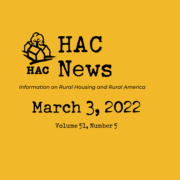
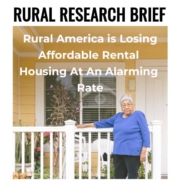 Housing Assistance Council
Housing Assistance Council